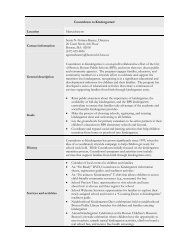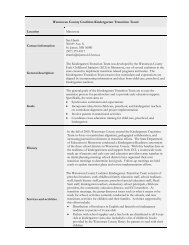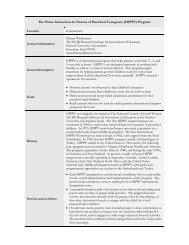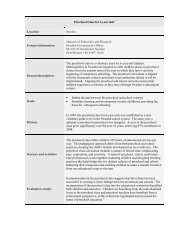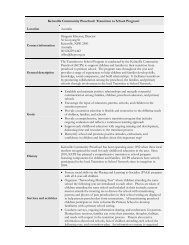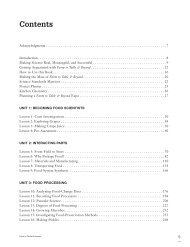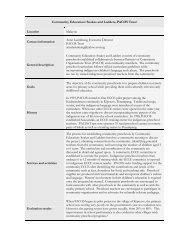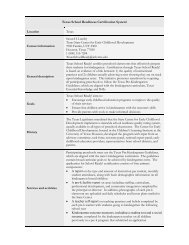Proceedings of the Fourth Annual Teachers College Educational ...
Proceedings of the Fourth Annual Teachers College Educational ...
Proceedings of the Fourth Annual Teachers College Educational ...
Create successful ePaper yourself
Turn your PDF publications into a flip-book with our unique Google optimized e-Paper software.
Meaningful clicks, significant bricks:<br />
Perceptions <strong>of</strong> creativity and agency in physical and virtual play<br />
Lillian Spina-Caza,<br />
Rensselaer Polytechnic Institute, 110 8th Street, Troy, NY 12180,<br />
Email: spinal@rpi.edu<br />
Abstract: Two important questions define this research: First, does how an activity is<br />
performed – physically or virtually – impact on young people’s perceptions <strong>of</strong> creativity<br />
and agency? And second, is <strong>the</strong>re a connection between mode, self-perceptions, and<br />
gender? An experimental field study conducted at a lower SES, rural elementary school<br />
comparing similar physical and virtual activity found <strong>the</strong> answer to both <strong>of</strong> <strong>the</strong>se<br />
questions is yes. The research presented here makes significant associations between<br />
virtual activity, gender, and young people’s sense <strong>of</strong> <strong>the</strong>ir own creative abilities emerging<br />
through <strong>the</strong> performance <strong>of</strong> play at a popular, commercial children’s Internet<br />
environment.<br />
Interactive Virtual Technology and Children’s Self-perceptions<br />
One <strong>of</strong> <strong>the</strong> “red” threads appearing throughout much <strong>of</strong> <strong>the</strong> literature on children and interactive virtual<br />
technology (IVT) use is a call for young people to be creators and not just consumers <strong>of</strong> computer culture,<br />
producers <strong>of</strong> and not just participants in <strong>the</strong> virtual worlds <strong>the</strong>y inhabit. Frequently, <strong>the</strong> main reasons<br />
cited for encouraging IVT use include <strong>the</strong> development <strong>of</strong> information technology (IT) pr<strong>of</strong>iciency, media<br />
literacy skills, scientific reasoning and spatial skills, and o<strong>the</strong>r informal educational opportunities (Gee,<br />
2007; Hayes, 2008; Kafai, 2006; Loveless, 2007; Livingstone, 2003). Equally compelling reasons for<br />
exploring <strong>the</strong> effects <strong>of</strong> IVT use on young people, however, include a deeper understanding <strong>of</strong> how virtual<br />
environments alter creativity and/or agency perceptions considered essential for a developing child<br />
(Bronfenbrenner, 2005; Craft, 2000; Hart, 1979; Healy, 1998).<br />
Activity Theory (AT) provides a solid basis for this research, as it acknowledges <strong>the</strong> role <strong>of</strong> both individual<br />
creativity and agency in human computer interaction (HCI) (Kaptelinin & Nardi, 2006). AT alone,<br />
however, does not tell <strong>the</strong> entire story. A child’s subjective experiences in virtual play can also provide<br />
critical insights into what types <strong>of</strong> IVT are most supportive <strong>of</strong> contributive play and, consequently, more<br />
supportive <strong>of</strong> learning and development. As Bronfenbrenner (1979) suggests, <strong>the</strong>re is an active and<br />
creative aspect to children’s play, and a young person’s belief in <strong>the</strong>ir ability to reshape or contribute<br />
something to his or her environment, to “discover, sustain, or alter its properties,” is a hallmark <strong>of</strong><br />
development (p. 10). Rog<strong>of</strong>f (1993), too, suggests, though individuals are bound to environment, a<br />
person may be transformed as <strong>the</strong>y “…make a process <strong>the</strong>ir own through <strong>the</strong>ir (necessarily creative)<br />
efforts to understand and contribute to social activity” (p. 141).<br />
AT is enriched by embracing both an Ecological Systems Theory (EST), which views human development<br />
as a process <strong>of</strong> a person’s interactions with his or her environment, and also a Creativity Theory <strong>of</strong><br />
Development (CTD) (Kozbelt, Beghetto & Runco, 2010), which suggests individual and environmental<br />
attributes support or constrain creative activity. The Creative Agency Model (CAM) introduced in this<br />
study brings toge<strong>the</strong>r elements <strong>of</strong> all three to operationalize creativity and agency in <strong>the</strong> context <strong>of</strong> IVT<br />
use. In this model, creativity and agency are considered processes or functions <strong>of</strong> activity-environments<br />
and performance-perceptions. Since <strong>the</strong>re is a dearth <strong>of</strong> empirical research measuring children’s<br />
confidence in <strong>the</strong>ir own creative abilities within <strong>the</strong> context <strong>of</strong> real or virtual activity, CAM <strong>of</strong>fers a robust<br />
way to explore <strong>the</strong> impact <strong>of</strong> moving activity from physical to virtual spaces.<br />
Breaking New Ground in Virtual Studies<br />
An experimental field study was conducted with 42 fourth and fifth graders at a rural, lower SES,<br />
elementary school in upstate New York, to compare <strong>the</strong> effects <strong>of</strong> similar physical and virtual play activity,<br />
isolating for gender. Significant effects were found for both creativity and agency perceptions in response<br />
to virtual play activity. Positive effects were gendered, with girls showing increases in several creativity<br />
dimensions, and boys showing an increase in one <strong>of</strong> four agency dimensions. For boys, feelings <strong>of</strong><br />
71



